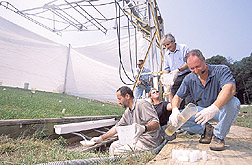Cleaning Up Runoff: Making
|
|
|
|
Pass by any dairy or cattle farm and the odor of manure will certainly leave an impression. But that's not all manure can leave behind. Pathogens in it can find their way into food and water supplies. Fecal bacteria—about 1 million of which are found in each gram of manure—include a range of beneficial and harmful microorganisms. Since many farmers use manure to fertilize their fields and pastures, they need an effective way to prevent harmful bacteria, like Escherichia coli O157:H7 and Salmonella, from reaching the water supply. ARS microbiologist Daniel R. Shelton, of the Animal Waste Pathogen Laboratory (AWPL) in Beltsville, Maryland, led a study of how such organisms are spread in the environment and whether grass buffer strips can filter them out. Shelton's collaborators included fellow AWPL researcher Yakov Pachepsky; Ali Sadeghi and James Starr, from the Environmental Quality Laboratory; former ARS researcher Asad Rouhi; and University of Maryland professor Adel Shirmohammadi and doctoral student Reza Roodsari. In 1999, Shelton and colleagues began studying how the protozoan Cryptosporidium parvum and the bacterium E. coli O157:H7 move through soil and in runoff water. Then they turned their sights on ways to slow that migration down. They planted grass strips on two 20-foot-long, 20-percent slopes of a wedge-shaped mound called a lysimeter. "The lysimeter is the smallest observation unit in which pathogen transport occurs in the same way as it does in the real world," explains Shelton. One slope of the mound had clay loam soil and another had sandy loam. Various indigenous grasses were grown on each soil type to test their filtering effects. Bare parts of the slopes were used as controls. Fresh manure from the Beltsville Agricultural Research Center's (BARC) dairy cows was applied along the top of the slopes. Through overhead sprinklers, designed and built by retired BARC machinist Paul Balsley, water was applied to the slopes, simulating rainfall. Runoff was sampled through tubes at various locations from the top of the hill to the bottom. The samples were analyzed for bacteria content, and the results were surprising. "Grass buffer strips were far more effective at filtering out manure-borne parasites than expected," says Shelton. "They stopped at least 90 percent of all rain runoff, so almost no bacteria moved down the mound. But most of the rain ran off both bare sides of the mound, carrying the bacteria with it." Runoff from the bare clay loam slope contained virtually all the pathogens present in the manure, but runoff from vegetated clay loam slope had only 0.6 percent pathogens. Bare sandy loam soil runoff contained 25 percent of the pathogens, but vegetated sandy loam soil runoff had none. Pathogens that remain in the soil either become food for other organisms or settle into an area between soil particles that doesn't support life, Shelton says. In either case, they'll die before they can infect food or water supplies.—By Sharon Durham, Agricultural Research Service Information Staff. This research is part of Water Quality and Management (#201) and Manure and Byproduct Utilization (#206), two ARS National Programs described on the World Wide Web at http://www.nps.ars.usda.gov. Daniel R. Shelton is with the USDA-ARS Animal Waste Pathogen Laboratory, 10300 Baltimore Blvd., Bldg. 173, Room 101, Beltsville, MD 20705; phone (301) 504-6582, fax (301) 504-6608. |
|
"Cleaning Up Runoff: Making Manure-borne Pathogens Stay Put" was published in the October 2002 issue of Agricultural Research magazine. |







